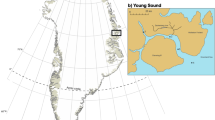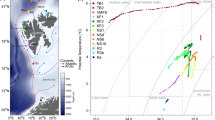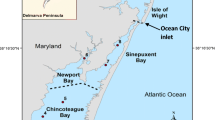Abstract
Growth and secondary production of pelagic copepods near Australia's North West Cape (21° 49′ S, 114° 14′ E) were measured during the austral summers of 1997/1998 and 1998/1999. Plankton communities were diverse, and dominated by copepods. To estimate copepod growth rates, we incubated artificial cohorts allocated to four morphotypes, comprising naupliar and copepodite stages of small calanoid and oithonid copepods. Growth rates ranging between 0.11 and 0.83 day−1 were low, considering the high ambient temperatures (23–28°C). Calanoid nauplii had a mean growth rate of 0.43±0.17 day-1 (SD) and calanoid copepodites of 0.38±0.13 day-1. Growth rates of oithonid nauplii and copepodites were marginally less (0.38±0.19 day−1 and 0.28±0.11 day−1 respectively). The observed growth rates were suggestive of severe food limitation. Although nauplii vastly outnumbered copepodite and adult copepods, copepodites comprised the most biomass. Copepodites also contributed most to secondary production, although adult egg production was sporadically important. The highest copepod production was recorded on the shelf break (60 mg C m-2 day-1). Mean secondary production over both shelf and shelf break stations was 12.6 mg C m-2 day-1. Annual copepod secondary production, assuming little seasonality, was estimated as ~ 3.4 g C m-2 year-1 (182 kJ m-2 year-1).





Similar content being viewed by others
References
Ayukai T, Miller D (1998) Phytoplankton biomass, production and grazing mortality in Exmouth Gulf, a shallow embayment on the arid, tropical coast of Western Australia. J Exp Mar Biol Ecol 225:239–251
Båmstedt U (1986) Chemical composition and energy content. In: Corner EDS, O'Hara SCM (eds) The biological chemistry of marine copepods. Clarendon Press, Oxford, pp 1–58
Beers JR (1966) Studies on the chemical composition of the major zooplankton groups in the Sargasso Sea off Bermuda. Limnol Oceanogr 11:520–528
Campbell RG, Runge JA, Durbin EG (2001) Evidence for food limitation of Calanus finmarchicus production rates on the southern flank of Georges Bank during April 1997. Deep Sea Res II 48:531–549
Chisholm LA, Roff JC (1990) Abundances, growth rates, and production of tropical neritic copepods off Kingston, Jamaica. Mar Biol 106:79–89
Escaravage V, Soetaert K (1993) Estimating the secondary production for the brackish Westerschelde copepod population Eurytemora affinis (Poppe) combining experimental data and field observations. Cah Biol Mar 34:201–214
Evans F (1977) Seasonal density and production estimates of the commoner planktonic copepods of Northumberland coastal waters. Estuar Coast Mar Sci 5:223–241
Fryer F (1986) Structure, function and behaviour, and the elucidation of evolution in copepods and other crustaceans. In: Schriever G, Schminke HK, Shih C-T (eds) Proceedings of the 2nd International Conference on Copepoda, Ottawa, Canada. Syllogeus Series 58. National Museums of Canada, Ottawa, pp 150–157
Gifford DJ (1993) Consumption of protozoa by copepods feeding on natural microplankton assemblages. In: Kemp PF, Sherr BF, Sherr EB, Cole JJ (eds) Current methods in aquatic microbial ecology. Lewis , Boca Raton, pp 723–729
Hernández-León S, Almeida C, Montero I (1995) The use of aspartate transcarbamylase activity to estimate growth rates in zooplankton. ICES J Mar Sci 52:377–383
Hirst AG, Lampitt RS (1998) Towards a global model of in situ weight-specific growth in marine planktonic copepods. Mar Biol 132:247–257
Hirst AG, Sheader M, Williams JA (1999) Annual pattern of calanoid copepod abundance, prosome length an minor role in pelagic carbon flux in the Solent, U.K. Mar Ecol Prog Ser 177:133–146
Holloway PE, Humphries SE, Atkinson M, Imberger J (1985) Mechanisms for nitrogen supply to the Australian North West Shelf. Aust J Mar Freshw Res 36:753–764
Hopcroft RR, Roff JC (1998a) Zooplankton growth rates: the influence of female size and resources on egg production of tropical marine copepods. Mar Biol 132:79–86
Hopcroft RR, Roff JC (1998b) Zooplankton growth rates: the influence of size in nauplii of tropical marine copepods. Mar Biol 132:87–96
Hopcroft RR, Roff JC (2003) Response of tropical marine phytoplankton communities to manipulations of nutrient concentration and metazoan grazing pressure. Bull Mar Sci (in press)
Hopcroft RR, Roff JC, Webber MK, Witt JDS (1998a) Zooplankton growth rates: the influence of size and resources tropical marine copepodites. Mar Biol 132:67–77
Hopcroft RR, Roff JC, Lombard D (1998b) Production of tropical copepods in Kingston Harbour, Jamaica: the importance of small species. Mar Biol 130:593–604
Huntley M, Lopez MDG (1992) Temperature-dependent production of marine copepods: a global synthesis. Am Nat 140:201–242
Hutchings L, Verheye HM, Mitchell-Innes BA, Peterson WT, Huggett JA, Painting SJ (1995) Copepod production in the southern Benguela system. ICES J Mar Sci 52:439–455
Kimmerer WJ, McKinnon AD (1987) Growth, mortality, and secondary production of the copepod Acartia tranteri in Westernport Bay, Australia. Limnol Oceanogr 32:14–28
Kiørboe T, Nielsen TG (1994) Regulation of zooplankton biomass and production in a temperate coastal ecosystem. 1. Copepods. Limnol Oceanogr 39:493–507
McKinnon AD (1996) Growth and development in the subtropical copepod Acrocalanus gibber. Limnol Oceanogr 1438–1447
McKinnon AD, Ayukai T (1996) Copepod egg production and food resources in Exmouth Gulf, Western Australia. Mar Freshw Res 47:595–603
McKinnon AD, Duggan S (2001) Summer egg production rates of paracalanid copepods in subtropical waters adjacent to Australia's North West Cape. Hydrobiologia 453/454:121–132
McKinnon AD, Thorrold SR (1993) Zooplankton community structure and copepod egg production in coastal waters of the central Great Barrier Reef lagoon. J Plankton Res 15:1387–1411
McLaren IA, Tremblay MJ, Corkett CJ, Roff JC (1989) Copepod production on the Scotian Shelf based on life-history analyses and laboratory rearings. Can J Fish Aquat Sci 46:560–583
Middlebrook K, Roff JC (1986) Comparison of methods for estimating annual productivity of the copepods Acartia hudsonica and Eurytemora herdmani in Passamaquoddy Bay, New Brunswick. Can J Fish Aquat Sci 43:656–664
Mullin MM (1988) Production and distribution of nauplii and recruitment variability–putting the pieces together. In: Rothschild BJ (ed) Toward a theory on biological-physical interactions in the world ocean. Kluwer , Dordrecht, pp 297–320
Newbury TK, Bartholomew EF (1976) Secondary production of microcopepods in the southern eutrophic basin of Kaneohe Bay, Oahu, Hawaiian Islands. Pac Sci 30:373–384
Parsons TR, Maita Y, Lalli CM (1984) A manual of chemical and biological methods for seawater analysis. Pergamon Press, Oxford, pp 1–187
Peterson WT, Hutchings L (1995) Distribution, abundance and production of the copepod Calanus agulhensis on the Agulhas Bank in relation to spatial variations in hydrography and chlorophyll concentration. J Plankton Res 17:2275–2294
Peterson WT, Tiselius P, Kiørboe T (1991) Copepod egg production, moulting and growth rates, and secondary production, in the Skagerrak in August 1988. J Plankton Res 13:131–154
Postel L, Fock H, Hagen W (2000) Biomass and abundance, Chap 4. In: Harris RP, Wiebe PH, Lenz J, Skjoldal HR, Huntley ME (eds) Zooplankton methodology manual. Academic Press, London
Richardson AJ, Verheye HM (1999) Growth rates of copepods in the southern Benguela upwelling system: the interplay between body size and food. Limnol Oceanogr 44:382–392
Roff JC, Kroetsch JT, Clarke AJ (1994) A radiochemical method for secondary production in planktonic crustacea based on rate of chitin synthesis. J Plankton Res 16:961–978
Sastri AR, Roff JC (2000) Rate of chitobiase degradation as a measure of development rate in planktonic Crustacea. Can J Fish Aquat Sci 57:1965–968
Smith SL (1995) The Arabian Sea: mesozooplankton response to seasonal climate in a tropical ocean. ICES J Mar Sci 52:427–438
Svetlichny LS (1983) Calculation of planktonic copepod biomass by means of coefficients of proportionality between volume and linear dimensions of the body. Sea Ecology-Kiev (Ecologia morja-Kiev, naukova dumka) 15:46–58
Tranter DJ (1962) Zooplankton abundance in Australasian waters. Aust J Mar Freshw Res 13:106–142
Tremblay MJ, Roff JC (1983) Production estimates for Scotian Shelf copepods based on mass specific P/B ratios. Can J Fish Aquat Sci 40:749–753
Uye SI, Shimazu T (1997) Geographical and seasonal variations in abundance, biomass and estimated production rates of meso- and macrozooplankton in the Inland Sea of Japan. J Oceanogr 53:529–538
Webber MK, Roff JC (1995) Annual biomass and production of the oceanic copepod community off Discovery Bay, Jamaica. Mar Biol 123:481–495
Acknowledgements
We wish to thank all involved in the North West Cape study, especially the crew of the R.V. "Lady Basten", for their help at sea. Miles Furnas generously offered help and support at all stages of this work. We thank Andrew Hirst, Russ Hopcroft and Wim Kimmerer for comments on an earlier draft of this manuscript.
Author information
Authors and Affiliations
Corresponding author
Additional information
Communicated by G.F. Humphrey, Sydney
Rights and permissions
About this article
Cite this article
McKinnon, A.D., Duggan, S. Summer copepod production in subtropical waters adjacent to Australia's North West Cape. Marine Biology 143, 897–907 (2003). https://doi.org/10.1007/s00227-003-1153-1
Received:
Accepted:
Published:
Issue Date:
DOI: https://doi.org/10.1007/s00227-003-1153-1




